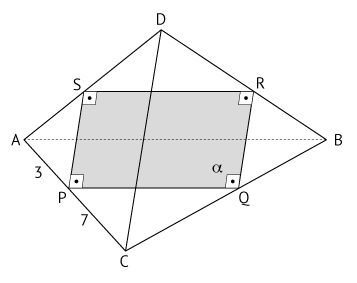Cada aresta do tetraedro regular ABCD mede 10. Por um ponto P na aresta  , passa o plano α paralelo às arestas
, passa o plano α paralelo às arestas  Dado que AP = 3, o quadrilátero determinado pelas interseções de α com as arestas do tetraedro tem área igual a
Dado que AP = 3, o quadrilátero determinado pelas interseções de α com as arestas do tetraedro tem área igual a

Sejam Q, R e S os pontos de intersecção de  com as arestas
com as arestas  ,
,  e
e  , respectivamente.
, respectivamente.
Como duas arestas reversas de um tetraedo regular são ortogonais,  é ortogonal a
é ortogonal a  .
.
 é paralela a
é paralela a  e
e  é paralela a
é paralela a  . Logo,
. Logo,  é perpendicular a
é perpendicular a  .
.
Analogamente,  é perpendicular a
é perpendicular a  e
e  é perpendicular a
é perpendicular a  . Portanto, o quadrilátero
. Portanto, o quadrilátero  é um retângulo.
é um retângulo.
Como AC = 10 e AP = 3, logo PC = 7.
Os triângulos APS e BQR são equiláteros de lado igual a 3.
Os triângulos CPQ e DRS são equiláteros de lado igual a 7. Portanto, a área do quadrilátero PQRS é: 3 · 7 = 21.


